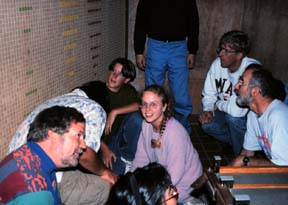
Teachers listen for sound at the nodes of the sound
column.

Teachers listen for sound at the nodes of the sound
column.
Introduction
Explorations to do inside the sound column exhibit at the Exploratorium. The sound column is a cement tube 20 m, 60 ft, high. There is a xylophone-like set of aluminum bars inside the sound column tuned to resonant frequencies of the column. Twenty people can stand in the column.
To do and Notice/ What’s going on?
Resonance
Hit the bars with a mallet, Listen to the long
sustain.
It’s in-tune today
“How do you know that?” Tap the bars gently with a finger
tip. Listen to the growth of the sound. When the sound wave in air
travels up the column and back in exactly the same time a bar
vibrates up and back then the sound is made louder at each pass. The
sound starts off soft and grows louder. When it’s out of tune
the sound builds and then decays as the bars and the sound wave move
in and out of phase, or the sound just never builds.
The bars are tuned by moving the steel bars on
their ends in and out.
The tuning of the column changes because the speed of sound changes,
the speed of sound in air is a function of the
temperature.
Vibration
Strike the largest plate, put a coin on the plate
and watch it bounce.
In the middle of the plate the coin bounces a lot, this is an
antinode. At the suspension the coin bounces a little.
Feeling sound
Place your hand near the top edge of a vibrating plate and feel the air vibrations which comprise the sound. You can feel loud, low frequency sounds as vibrations.
Hearing sound at nodes
Bend down and put your ear near the floor. The floor is a node of motion for the sound wave. You can hear the sound quite clearly. raise your head off the floor, at some point the sound will fade away almost completely, this point is an antinode, i.e. at that point the air molecules are moving back and forth with their greatest amplitude. This shows that your ear is an instrument which picks up pressure changes not the displacement of the air.
A deep Philosophical Question
Play two adjacent bars listen to the beat note. Move your ear up and down from the pressure node of the sound from one bar to the pressure node of the other. With your ear at the node you can only hear one note at a time. If you play three notes at a time and move your head just right you can play a tune. This raises the question, is the tune in the air of the sound column or not?
Math Root
Note the tile pattern on the wall. The pattern
shows the standing wave of pressure produced by each bar. The
patterns are color coded, so are the bars.
How many of the longest waves are there in the column? Note that only
a half wavelength is portrayed. There are four half-waves in the
column so the lowest note is the 4’th harmonic of the column.
Six half-waves of the second note fit into the column so the second
note is the 6’th harmonic. The fundamental frequency of the
column is 7.5 hertz. The fourth harmonic is 30 Hz, just barely within
the range of human hearing which extends down to 20 Hz.
Beats
The beat frequency which you hear when you play two adjacent bars simultaneously is the difference in the frequency of the two notes. The difference in frequency between two adjacent bars is two times the fundamental frequency of the column, 15 Hz. You do not hear 15 Hz as a tone, you hear it as a beat.
The Ultimate Shower Stall
Sing a note in the column
This is the ultimate shower stall experience because the
“good” notes are resonantly amplified, the bad ones just
hang there without getting louder. Good notes are those which
resonate, these resonances have a melodious musical relationship with
each other. The notes also last a long time because the sound waves
in the column cannot spread out, and there is little in the column
except human bodies to turn the sound waves into heat.
You see why it might be fun to sing in a
cathedral, although the staff of most cathedrals frown on people who
just drop by to explore the resonances.
I search out long concrete pedestrian underpasses. Sounds will
resonates inside these concrete tunnels by bouncing off the open
ends.
A Sound Laser
The sound inside the sound column builds up in a
resonance similar to the way light resonates between the mirrors at
the end of a laser.
|
Scientific Explorations with Paul Doherty |
|
25 May 2000 |